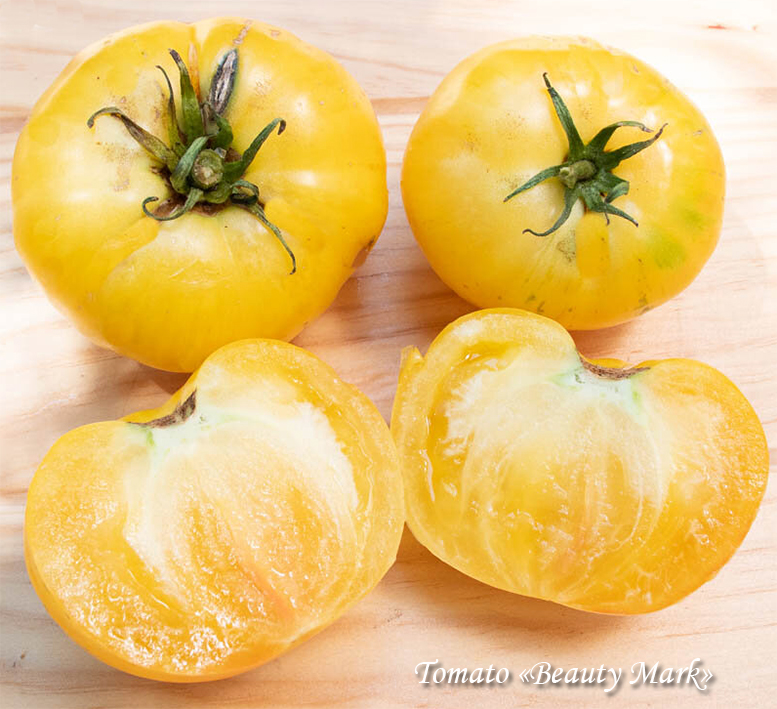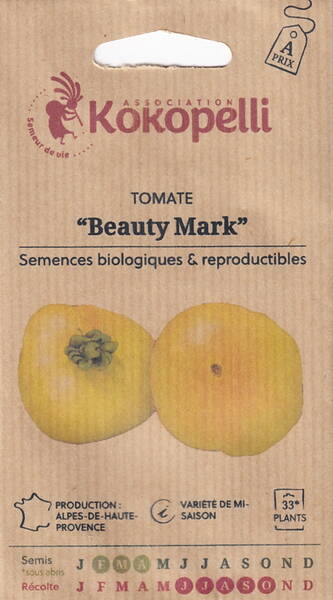A mid-season variety developed by Tom Wagner, it has medium-sized fruits with variegated coloration.
Their aromatic flesh reveals citrus notes. The fruits may vary in color, shape, and taste.
Growth type: Indeterminate.
Historical origin: USA
Description: This variety, recently developed by Tom Wagner, is the result of a cross between the 'White Brandy' and 'Brandy Stripes' varieties.

* Many amateur gardeners prefer to use only organic fertilizers, believing that this will allow them to get rid of nitrates...
Not at all: nitrates were and always will be! Both in the soil and in plants. And there is no escape for us from this natural process.
Nitrates are salts of nitric acid. They are highly soluble in water, easily migrate, and can accumulate in significant quantities in the root layer of soil, and consequently, in plants. Salts of nitric acid are widely used as effective nitrogen fertilizers: ammonium nitrate NH4NO3, sodium nitrate NaNO3, calcium nitrate Ca(NO3)2; as well as urea (carbamide), where ammonia often converts to the nitrate form.
When high doses of nitrogen fertilizers are applied, even those not containing nitric acid salts (nitrates), such as ammonium fertilizers, a large amount of nitrates can still accumulate in the soil as a result of the nitrification process. It is important that nitrates do not accumulate in plants in excessive quantities - this is dangerous for the human body (especially children).
Nitrates reduce the activity of digestive enzymes and cause gastrointestinal disorders. The safe daily dose of nitrates is 5 mg per kilogram of body weight (for a person weighing 70 kg, the permissible nitrate dose is no more than 350 mg). Drinking water can contain up to 45 mg/l of nitrates. Permissible nitrate levels in mg/kg are: potatoes 250; early cabbage 900, late cabbage - 500, carrots 250, cucumbers and tomatoes 150, beets - 1400, green vegetables (lettuce, spinach, sorrel, parsley) - up to 2000, peppers - 200, melons - 90, watermelons - 60, zucchini - 400, onions - 80.
Accumulation of nitrates in agricultural products can be avoided by adhering to the following rules:
1. Do not apply large doses of nitrogen fertilizers to the soil, especially if manure, peat, humus, or other organic matter is frequently applied. Nitrogen fertilizer doses are reduced by 40 - 50% on peaty soils. It is better to apply nitrogen fertilizers in split applications during the growing season. Split application is particularly effective on drained soils, where a significant amount of nitrates is dangerous not only due to their entry into agricultural products but also because of possible pollution of water bodies and streams.
2. Avoid one-sided application of any mineral fertilizers. Plant nutrition must be balanced in all elements. Plants should have a well-developed leaf apparatus, then nitrates are actively involved in protein metabolism processes.
3. Periods of prolonged rains reduce photosynthetic activity and protein synthesis activity, creating a threat of nitrate accumulation. During these periods, it is better not to consume plants raw but to process them.
Different types of agricultural plants accumulate different amounts of nitrates under the same soil and other conditions. The greatest ability for such accumulation is found in lettuce, garden cress, spinach, head cabbage, rhubarb, radish, parsley, spring radish.
Minimal accumulation is characteristic of tomatoes, eggplants, and onions. Under normal conditions, nitrates generally do not accumulate in the fruits of apple, cherry, plum trees, or in the berries of currants and gooseberries. It is significant that nitrates are concentrated mainly in the vegetative organs of fruit plants (in leaves and stems).
Vegetable plants of the cucurbit family - zucchini, pattypan squash, cucumbers, melons, watermelons - are characterized by an increased ability to accumulate nitrates in their fruits.
Among root vegetables, beets have a high ability to accumulate nitrates.
In cabbage, the maximum accumulation is in the outer leaves and the core; in cucumber fruits, the nitrate content increases from the blossom end to the stem end. Their maximum is in the skin and less in the pulp. In zucchini fruits, it decreases from the stem end to the blossom end; in pattypan squash - from the periphery to the center. In carrots, the nitrate content in the core of the root is higher than in the outer part and decreases from the root tip to the top. In beets, the zones of high content are the top and the root tip.
Young plants of early varieties have a higher nitrate content than adult plants and late varieties.
Nitrate content in plants is significantly reduced during processing. When fermenting and pickling cabbage - by more than 2 times; in peeled boiled potato tubers - by 3 times, in unpeeled boiled ones - only by 1 - 2 times.
There are a number of commonly used effective techniques to reduce high nitrate content. One of them is possibly extending the plant's growing season.
And one more thing: do not spare water for intensive irrigation of vegetables a few days before harvest.












